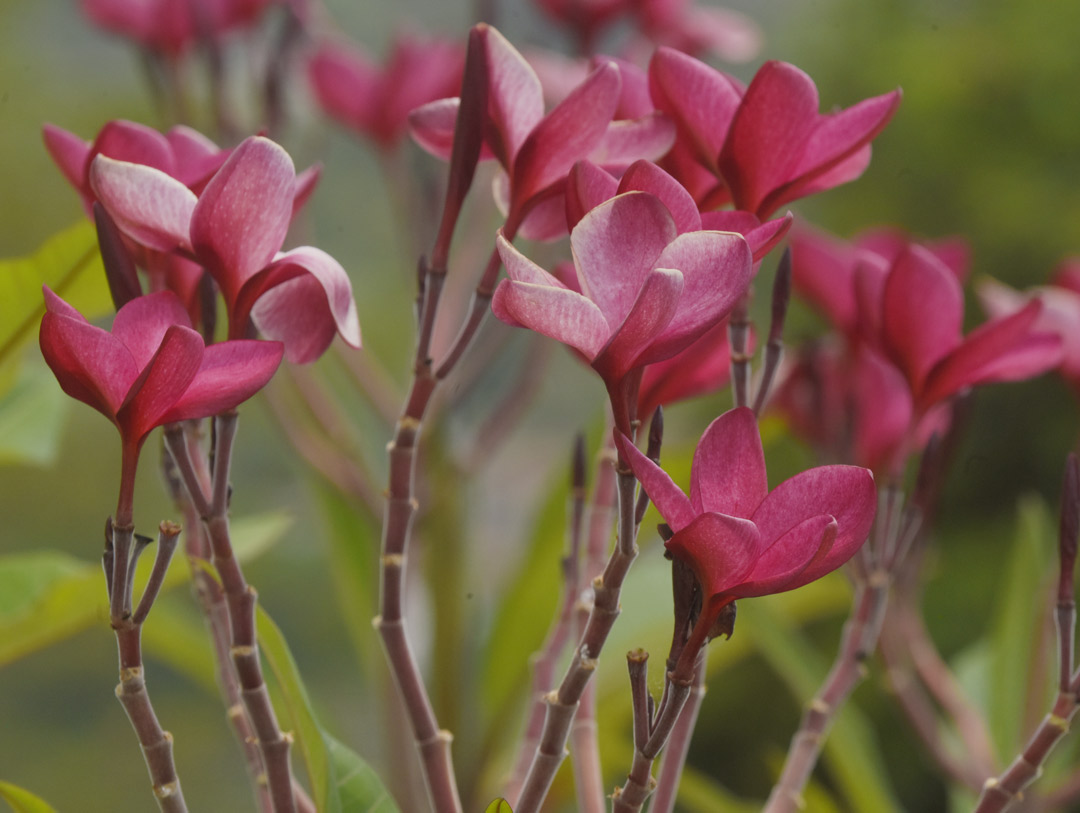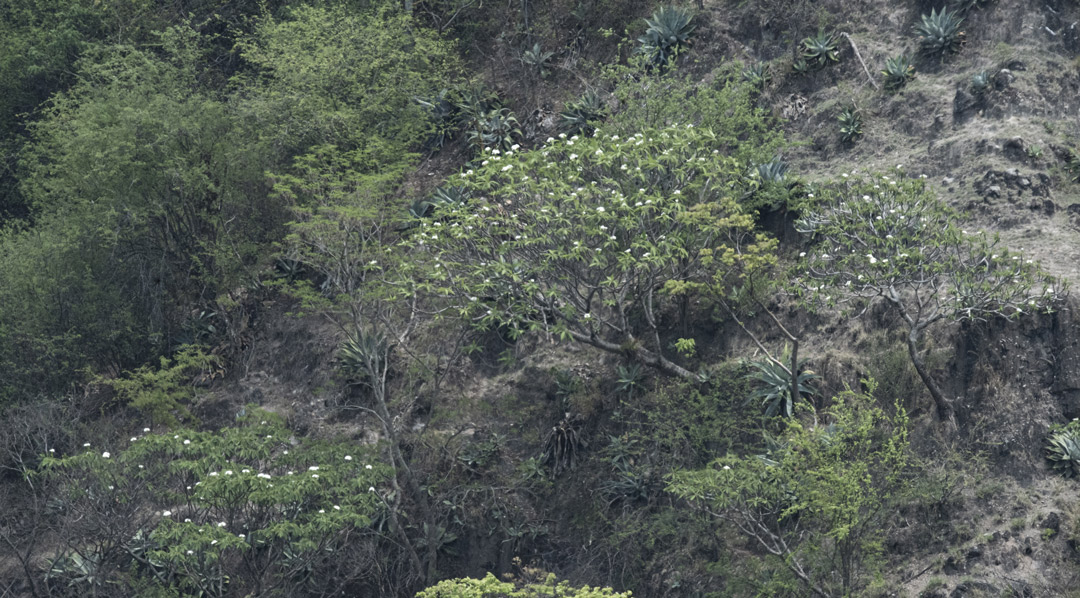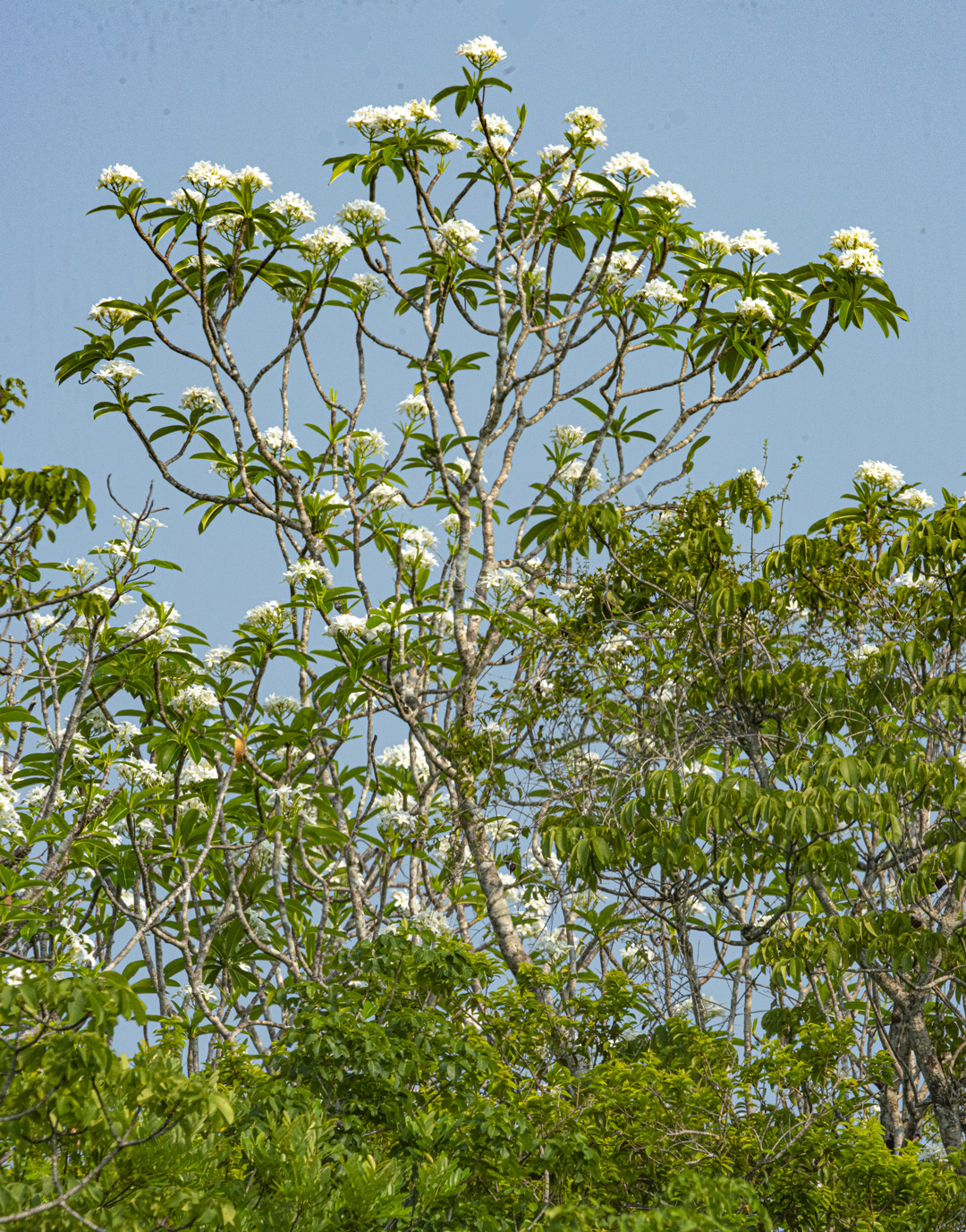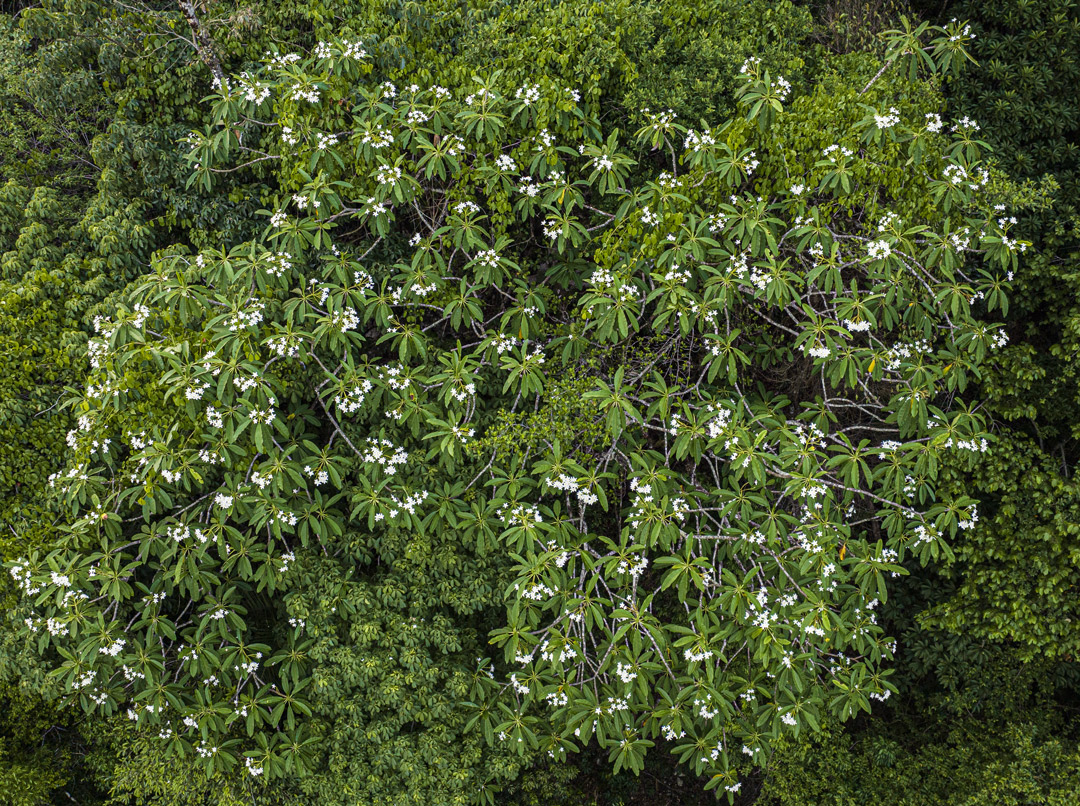Wild Plumeria rubra is native throughout Guatemala
During field trips of 2011, 2015 and 2023 the FLAAR teams have found and photographed Plumeria rubra wild in Peten, Izabal, El Quiche, El Progreso, Zacapa, Chiquimula, Santa Rosa and several other areas of Guatemala. We are preparing a list of everywhere we have found frangipani, flor de mayo, sac nicte flowering out in the wild during our several years of field trips. We drive through each hilly area of Guatemala that is likely to have wild native Plumeria rubra. We stop and photograph every single tree when possible (often there is no shoulder on the highway so we don’t stop but we note the tree coordinates). In recent three months of 2023 (April, May and June) we have driven over 2,500 kilometers through more areas than any other botanical or ethnobotanical team has attempted to achieve.
What colors are Plumeria rubra, frangipani, flor de mayo flowers?
Many (but not all) cemeteries in rural areas of Guatemala have Plumeria trees. 90% are various shades of red; a few are white.
Cemetery along unpaved road RD Pro-06 rowards Morazon, El Progreso, flowering May 18, 2023. Photo by Nicholas Hellmuth, Nikon D810, 200mm tele-macro lens.
Red, yellow, and other color Plumeria rubra are garden plants. They grow in a garden almost anywhere and everywhere around the world that is not freezing cold.
Wild Plumeria rubra shrubs and trees are white in color, with yellow centers. Lots of other colors are also pre-Hispanic but are garden varieties of the Mayan people (so red, maroon, dark colors and pure yellow) grow only in gardens, never out in the wild. If you find a colored frangipani outside it is escaped from a nearby house or in a previous decade there was a house that is no longer there (Mayan houses of wood with palm thatch are bio-degradable).
Obviously the deep red flowers attract the most attention. Ethnobotanist Suzanne Cook provides helpful information for the Yucatec-Lacandon-speaking Maya of Chiapas in her The Forest of the Lacandon Maya, An Ethnobotanical Guide:
chäk nikte' frangipani (pagoda tree, plumeria, temple tree, West Indian jasmine). Lit: ‘red blossom tree’. Apocynaceae Plumeria rubra f. rubra. This is a medium-sized, evergreen tree bearing fragrant, rose-coloured blossoms. It grows wild but is also cultivated as an ornamental. According to Tozzer (1907: 93), Plumeria rubra was the birth father of nohochakyum (Hachäkyum), the Lacandones' supreme deity, but Bruce and my northern Lacandon consultants say that the birth flower of the principal deities was baknikte' (Polianthus tuberosa). According to AM, the blossoms of the chäk nikte' are the perfume of the gods. Sim: säk nikte' ‘white nikte’ (Plumeria rubra)’; Gen: nikte' (ah). Thes: che' (Fig. 5.28a, b ). [Note: Botanical name from Pennington and Sarukhán (2005: 450). chak-nikte. Plumeria rubra (Nations 1992, in Atran et al. 2004); chak nicté [Yuc.]. Plumeria rubra (Roys 1931); chak-nik-te' [Yuc.]. frangipani. Plumeria rubra (Bricker et al. 1998); aj/ix chäk nikte' [Itz.]. Plumeria rubra (Atran et al. 2004). [Source: AM; BM] [ \sd2 other] (Cook 2016: 127). Spelling is usually Polianthes tuberosa It is super-helpful that she recognizes the difference between sac nikte’ and bac nicte’. Polianthes tuberosa, flor de nardo, in Guatemala, is found primarily in plantations of the Costa Sur to raise for selling as aromatic flowers for your home (the flowers, not the whole plant). Polianthus tuberosa is in the family Asparagaceae, Agave family. On Neotropical Flora database there are ZERO records for Polianthes tuberosa. Note that the record derives from Tropicos (data supplied on 2012-04-18 ) does not establish this name either as an accepted name or as a synonym (record 1201254). But other botanists accept Polianthes tuberosa as an accepted name www.theplantlist.org/tpl1.1/record/kew-285734
Plumeria rubra common names
The common name (in Guatemala) often depends on whether you ask a botanist or a local plant-focused individual; or local people living in the area. Not everyone knows the name for every plant that surrounds them (including me; my memory cells can remember only a few hundred plant names). Flor de mayo, flor de cruz are the most common local names for Plumeria rubra. Some local people simply call it flor blanco (white flower, since WILD native Plumeria rubra are always white, with small yellow center).
Sac nicte is a name in several Mayan languages but is sometimes confused by ethnobotanists and ethnohistorians with bac nicte; this mess we will address in our book-in-progress. Sac means white; nicte is flower of a tree (or often generic flower; depends on the context and the species). Another spelling is Säk-nik-te’.
Nicte-chom is another name in other Mayan languages. Nicte chom (with or without hyphen) has potential association with Plumeria rubra but there are other trees that bloom the same month of May, adjacent to Plumeria rubra, and have 5-petalled flowers also. So chom (or ch’om) may be a more generic name since it can also mean vulture (depending on which of the over 21+ Mayan languages you are looking at).
Cacalosúchil is one spelling for the Aztec name (Nahuatl language) for Plumera rubra. Other spelling is cacaloxochitl which is the spelling I prefer. Xochitl is flower in Nahuatl. Cacalotl is translated as Cuervo in Spanish. Cuervo can be a bird or can have lots of other popular meanings. So frangipani in Nahuatl language deserves much more linguistic and iconographic research (which we are undertaking for our book-in-progress on Plumera rubra flowers of Guatemala). Same flowers are very common across many areas of Mexico, but Belize experts list Plumeria obtusa, a completely different species name for that part of Mesoamerica. This is why the team at FLAAR (USA) together with FLAAR Mesoamerica (Guatemala) are criss-crossing all Guatemala to find and photograph the flowers of every different regional variant so that botanists can decide how to handle the mish-mash of nomenclature (more than just synonyms).
Nosegay is a common name listed by MOBOT (the prestigious Missouri Botanical Garden). www.missouribotanicalgarden.org/PlantFinder/PlantFinderDetails.aspx?taxonid=276072
Mayflower is another name (flower of month of May; this is the primary designation in Spanish of Mesoamerica: flor de mayo). In each other country (outside Guatemala) you can find additional local names.
Since there description is based on garden varieties and botanical specimens, I would suggest adding “white with yellow center” since 100% of wild Plumeria rubra plants are neither pink to red; 100% are white. We have traveled over 2,500 kilometers in the recent six weeks to see, study, photograph, document Plumeria rubra literally “all across Guatemala”. We also undertook field trips to study wild native frangipani shrubs and small trees in 2015 and other years.
Sajuancoche or spelled Sacuancoche (I prefer to translate Sac as meaning white though wild there is always a yellow center area of the white-petalled flowers) is used in Nicaragua where Plumeria rubra is the national flower.
Templetree is given by U.S. Fish & Wildlife Service but I have never heard that name (www.fws.gov/species/frangipani-plumeria-rubra). I estimate this name comes from Asia; not Mesoamerica.
Accepted botanical name is Plumeria rubra L, Family: Apocynaceae.
When do Plumeria rubra, Frangipani, Flor de Maya, flower?
In mid-April a good number of Plumeria rubra were flowering from km. 84 to km 100 along Highway CA14. and late April 2023 even more were flowering. Much to our surprise, on June 8th even more were flowering near KM 90 (uphill from El Rancho, the turnoff of CA14 from CA9).
In some areas we have seen Plumeria flowering continuously through July and August. Yet while on May 1st, 2023 the Plumeria rubra at Vuelta del Quetzal was flowering all across its top. On June 7th the same year only a few flowers remained on the same tree.
So when and how long frangipani flower out in the wild in its native habitat of Guatemala varies by area. Whether it depends on age of the tree or soil is another question. More likely by weather (which changes every several years nowadays).
Plumeria rubra uses?
#1 use is as a garden decoration.
#2 use is for perfume or to provide fragrance in the garden
#3 is Plumeria rubra as a medicinal plant
#4 is as flavoring, so edible
The flavoring (edible) uses of frangipani we will discuss as soon as outside funding comes our way so we can produce a monumental coffee table book on flor de mayo, frangipani of Guatemala. FLAAR now has the largest photo archive in the world of high-resolution digital photos of all aspects of Plumeria rubra of the Maya heartland (Guatemala). Other species grow in other countries; we estimate that over 90% of more of Plumeria genus in Guatemala is Plumeria rubra species.
Maya sacred plants should consider and even feature Plumeria rubra. I would also consider frangipani as potential Maya ethnobotanicals. Since frangipani is such a common and popular garden plant around the world, we often forget it deserving to be considered part of Maya ethnobotanicals.
Sap, resin, latex of Plumeria rubra
The branches of Plumeria rubra are easy to break off; the wood is flexible and not “hardwood”. But when you break off a branch, it oozes white latex-like thick milky goo. Do not taste test this (so don’t lick it off your fingers and clean your fingers before you use them to pick your nose or clean the corners of your eyes).
The symbolic meaning to the Maya is notable. We will be studying this as we continue our research on the ethnobotanical aspects of Säk-nik-te’. Can also be spelled Zac nicte.
In what Habitat can you expect to find Plumeria rubra in the wild?
The best known location for wild Plumeria rubra is in rocky dry areas with scrubby vegetation and both candelabra and prickly pear cactus (plus other cacti).
And I estimate that more than 90% of wild Plumeria rubra are on hillsides, often quite steep. This small tree or large shrub can also grow from steep rock cliffs.
I estimate that one reason you see Plumeria rubra in steep areas is because flat areas are chopped down then burned over for slash-and-burn milpa agriculture. But cliffs along streams or cliffs on hills are neither cut nor burned during the recent several thousand years (from the Preclassic Maya through today).
In the steep hills west of Lanquin caves and then many kilometers east on steep hills towards Cahabon, Alta Verapaz, we found so many Plumeria rubra in full bloom in May 23, 2023 that we spent the night in Cahabon so we could return the following morning and do even more photography.
There are also lots of Plumeria rubra on hillsides overlooking Aldea Santa Rosa, San Juan Sacatepequez. This is what we show above.
Photo by Nicholas Hellmuth, May 23, 2023, Nikon D5 with 800mm prime telephoto lens (Nikkor is the name for Nikon lenses).
Is Plumeria rubra a Tree or a Shrub?
Sometimes flor de mayo are a small tree (but 90% with very thin trunk). Branches are rarely horizontal; more diagonal or curve out then go up diagonally. Large tree size and shape does occur but rarely. Often Plumeria rubra are considered large shrubs (when young). When surrounded by a forest it is often a dry scrub forest but in different parts of Guatemala you can find all kinds of different surrounding vegetation, even tall pine (with the Plumeria nowhere near that tall and somehow surviving even in partial shade).
Trunk is usually thin (as you see here). Branches usually go more horizontal than this tree but at least many here go diagonally. Most of these trees have their treetops almost solid flowers (if seen from above) at the height of their flowering period.
Thicker trunks occur in cemeteries and in steep areas where the natural vegetation is neither chopped down nor burned down for milpa agriculture.
The hills east of La Libertad have lots of Plumeria rubra. These hills are on the north side of the turnoff east of the town from the highway going from San Benito (Santa Elena/Flores) towards Sayaxche.
Photo by Nicholas Hellmuth with iPhone 14. Pro Max, May 17, 2023, 8:14 am.
Trunk is usually thin (as you see here). Branches usually go more horizontal than this tree but at least many here go diagonally. Most of these trees have their treetops almost solid flowers (if seen from above) at the height of their flowering period.
Thicker trunks occur in cemeteries and in steep areas where the natural vegetation is neither chopped down nor burned down for milpa agriculture.
The hills east of La Libertad have lots of Plumeria rubra. These hills are on the north side of the turnoff east of the town from the highway going from San Benito (Santa Elena/Flores) towards Sayaxche.
Photo by Nicholas Hellmuth with iPhone 14. Pro Max, May 17, 2023, 8:14 am.
FLAAR has the largest digital photo archive in the world of aerial photos of Plumeria rubra flowering trees of Guatemala.
FLAAR also has the largest digital photo archive in the world of photos of the flowers, to show the difference in size and shape of the petals for each different biodiverse habitat in Guatemala.
We would like to provide these hundreds and hundreds of photos to a botanical database, to a botanical club, to a university or to a Plumeria association in exchange, cooperation, and coordination to publish two horizontal double-page format coffee-table books (one on Plumeria surrounded by cacti in dry areas of Guatemala; one on Plumeria surrounded by green forests and/or pines in other areas of Guatemala; plus a third summery coffee-table book with complete botanical, ethnobotanical, ethnohistorical about the role of Plumeria flowers in Classic and Post Classic Maya civilization.
Would be great to have these three volumes both in-print and digital, so the world can see the regional varients within Guatemala and learn about sac nicte flowers (frangipani flowers of Plumeria rubra) were revered by the Maya for thousands of years.
FrontDesk symbol FLAAR.org is how to reach us (put the actual symbol and close the empty space). You can consider starting by flying Dr Nicholas Hellmuth to your city so he can present a 1-hour full-color presentations. Hellmuth has lectured on various topics in Japan, China, Taiwan, UK, across USA, across Mexico and Central America, Dubai, Abu Dhabi, Austria, Germany, Greece, South Africa and elsewhere around the world. The lecture fee will cover the cost of the FLAAR team to prepare the PowerPoint from many years over many decades of high-resolution digital photography of Plumeria trees of Guatemala, Central America.
How to care for Plumeria rubra in your home garden
Simply take a cutting from the plant and stick it into the ground (take several; stick some in right away; let others dry and then stick them in the ground).
Plumeria rubra survive long dry season, but it helps to water them at least every few weeks in dry months. I doubt this shrub or tree can withstand cold.
Planted in a pot they flower when only a few feet high (but depends where you took the cutting from the original tree). Some of our cuttings have grown to over 3 meters high and did not yet flower.
Plumeria rubra don’t need much care. They grow well (obviously since our FLAAR Ethnobotanical Research Garden is in Neotropical Guatemala, albeit at 1,500 meters above sea level; their natural habitat is much lower elevation).
Bibliography on wild Plumeria rubra native to Guatemala
The references cited and list of additional suggested reading will be included in the book-in-progress.
First posted June 9, 2022.

















































































